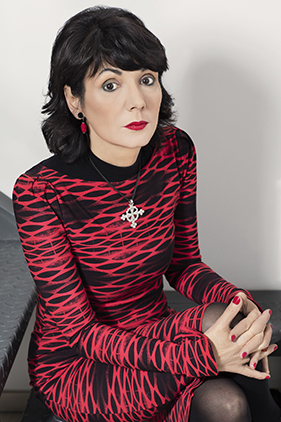February 2018, Year X, n. 2
Elisabetta Sgarbi
The Captain of the Publishing Industry
“We complain that our country doesn’t read much but, oddly enough, we believe that overall the publishing system is okay just the way it is. Actually, the Italian system is extremely concentrated. Pathologically concentrated. One publisher has 35% of the market for books (which is naturally going to grow), TV broadcasters, newspapers, a chain of bookstores. The second publisher has 10-11%.”
Telos: What do you think about contemporary publishing in an Italy that doesn’t read?
Elisabetta Sgarbi: Italy has always been a country with little interest in books and a low propensity to read. Obviously, there are several historical and cultural reasons for this. One reason certainly lies in the schools. However, besides these reasons, in Italy the system that revolves around books (which means distributors, retailers, publishers) has some anomalies in comparison with other countries. And we Italians have decided that these anomalies are normal. We complain that our country doesn’t read much but, oddly enough, we believe that overall the publishing system is okay just the way it is. Actually, the Italian system is extremely concentrated. Pathologically concentrated. One publisher has 35% of the market for books (which is naturally going to grow), TV broadcasters, newspapers, a chain of bookstores. The second publisher has 10-11%. More should be done for independent bookstores; the possibility of the market becoming so concentrated should have been prevented. The market is not this concentrated anywhere else in the world.
You started your professional career with longstanding Milan publisher Bompiani, and now you’re leading an independent publishing house. Could you tell us how this necessary change came about? And what exactly is the publishing house independent of?
Actually, I started my career with Studio Tesi in Pordenone. I came to Bompiani on the recommendation of a great writer who is also a very good friend of mine, Gian Antonio Cibotto. Gian Antonio recommended me to Mario Andreose, who at the time was the Editorial Director of Bompiani, Fabbri and Sonzogno. But, at any rate, my, our leaving Bompiani (because I left along with other publishers and authors, Eco being the first) was the culmination of a situation that led me to sever my relationship with Mondadori. Before resigning, I had actually been talking with the managers of Mondadori for a long time to try to find a solution and some common ground between some of Bompiani’s most important authors (especially Eco, but Veronesi and Nesi as well) and Mondadori. No agreement was reached and – since when I say I’m going to do something, I do it – I resigned. One curious thing: I told the CEO of Mondadori – not only did they seriously risk losing Bompiani because of the Anti-trust regulations – how much a new publishing house with the authors that were going to leave Bompiani would make in revenues: ten million euros. We made 14 million. In any case, La Nave di Teseo is a reaction to the odd market I mentioned earlier, a market where the publisher with the largest market share has over 35% and the second, 10%. ‘Independent’ means that the publisher is not part of a group that has substantial interests in other sectors besides books. And now La Nave di Teseo is a publishing group made up of La Nave di Teseo, Baldini&Castoldi (we’ve just designed a new logo with Cerri’s design firm) and Oblomov, directed by Igort, which focuses on graphic novels.
Claudio Magris has described you as ‘a captain who deals with, meets, approves, rejects, corrects and creates books and authors every day’. Is a publisher’s job truly this epic?
Far more than that because it’s an epic that’s invisible, silent, behind-the-scenes; and perhaps this is why there’s more freedom. Anyway, Magris was very generous with me. Flaiano comes to mind, now that you ask me what it means to be a publisher: it means mediating between two worlds, one is the market, made up of rules and results, laws and money; the other is impalpable, it’s artistic creation, undefined. The publishing industry is a paradox: it’s a very complex structure that rests on something intangible, that is, to freely quote Flaiano, ‘with its feet firmly planted in the clouds’.
Since 2000 you’ve started to branch out into cinema and writing, with a bit of cinema on art, some documentaries and your last film about the earth and humanity. What inspired your passion for directing and how do you think it will evolve?
Cinema is just as important to me as my publishing life. There’s always plenty of literature in my cinema. It’s a passion, meaning that it’s a force that draws me in and takes me away, in directions I don’t know, but that cinema knows. Cinema is that part of me that writes in images. It’s how you view things. And that view is the world. This is precisely the concept I illustrate in Deserto Rosa, a film arranged into five seasons inspired by the photographs of the great photographer Luigi Ghirri.
Marco Sonsini
Editorial
Let’s step into the shoes of the people who don’t read. They have to endure the raised eyebrows of those who read, and the haughtiness of those who read a lot. Not to mention Pubblicità Progresso and its public service announcements inviting people to read to be better people. It’s almost as if readers, the ones who read a lot and who boast about reading a lot, just want to give people who don’t read much an inferiority complex. I sometimes imagine that non-readers can barely keep themselves from beating readers over their heads with hardback editions of The Complete Works of James Joyce or Umberto Eco. One thing we do know for certain, however, is that in Italy people don’t read much; actually, they read very little. The latest available statistics show that the percentage of readers has continued to drop, from 42% in 2015 to 40.5% in 2016. These data from the Italian National Institute of Statistics (ISTAT) are what have allowed us to create an identikit of the Italian reader: more women read than men and there are more readers between the ages of 11 and 14. Among adults, there are more university graduates and increasingly fewer Southern Italians who read, whereas the strongest readers live in the Northeast. By contrast, if we look at the islands and the south, Sardinia is one of the regions where people read the most at 45.7%. Within this desolate landscape of a country where everybody claims to love culture but nobody reads, we couldn’t help but turn to the queen of publishing in Italy, Elisabetta Sgarbi, to find out more about it. Sgarbi reminds us that the fact that few Italians read shouldn’t come as a huge surprise. It’s almost a cultural given, rooted in the fact that schools, for instance, do little to foster a love of reading and in Italy’s anomalous, almost oligopolistic, publishing system, which certainly doesn’t help matters much. To break from this world, in 2016 she founded a new publishing house, La Nave di Teseo, after spending several months, during the acquisition of longstanding Milan publisher Bompiani, trying to strike a compromise with their new owner, Italian publishing giant Mondadori, and Rizzoli-Corriere della Sera Media Group (RCS). When she figured out that a compromise was impossible, she informed Eco and the other authors in the group of their standpoints. They acknowledged this and decided to go on to something new. Today’s publishing market isn’t great, but it essentially sticks to its values and fiction continues to be the best-selling genre. What does this mean and what does being a publisher entail? In 2015 Claudio Magris described Elisabetta in the following way in the preface to Giuseppe Sgarbi’s second novel Non chiedere cosa sarà il futuro: ‘The courageous, extremely clear-thinking, unyielding, fearless admiral of a large, adventurous publishing fleet; a captain who deals with, meets, approves, rejects, corrects and creates books and authors everyday’. Sgarbi very elegantly tells us that a publisher’s job truly is epic, but that ‘at any rate, Magris was very generous with me’. ‘Elegance’ is a word that is often used when talking about Elisabetta Sgarbi, and it’s what I hope will come to mind when you see the 2018 covers of Primo Piano Scala c. The graphics we’ve selected for this year are rather unique: we thought we would explore the theme of fonts by playing with how they could be used. Each month represents a decade of the twentieth and twenty-first centuries. Each decade corresponds to a font that was invented during that period, which is used to write the name of the person interviewed, who is then portrayed dressed according to the style of the era of that particular font: the January cover is dedicated the 1910s and shows Giulio Ranzo wearing a tailcoat, while Elisabetta Sgarbi just happened to get the 1920s. Superchic!
Mariella Palazzolo

Elisabetta Sgarbi is a publisher, director, writer. Gian Antonio Cibotti, an Italian writer, recommended her to Pordenone publisher Edizioni Studio Tesi, where she began working as a reader. Not for long, though. She soon met Mario Andreose, who asked if she wanted to begin working for Bompiani as its media relations manager. She left this position almost immediately as well to rise through the ranks of the publishing house until becoming its Editorial Director. She was also the editor of Panta magazine. In 2000 she founded the cultural review La Milanesiana, of which she is still the editor. From the very first edition, La Milanesiana has been a major laboratory for excellence in literature, cinema, music, art, science and philosophy. In November 2015 Elisabetta Sgarbi left Bompiani just after it changed hands from Rizzoli-Corriere della Sera (RCS) Media Group to Arnoldo Mondadori Editore. In opposition to the merger between Mondadori and Rizzoli, she and many other writers, such as Umberto Eco, Sandro Veronesi, Tahar Ben Jelloun, Edoardo Nesi, Furio Colombo, Sergio Claudio Perroni, Nuccio Ordine, Mario Andreose, Eugenio Lio and Mauro Covacich, founded a new publishing house, La Nave di Teseo. In June 2017 it acquired Baldini&Castoldi and Sgarbi became the President of the publishing house. Elisabetta is also a prolific filmmaker, with a production named Betty Wrong as she is known to her friends and admirers. However, in addition to making films, she is also a writer and has published several books, such as Portraits. I volti della milanesiana 2000-2009. La milanesiana dieci anni (Lubrina-LEB 2009, with Mario Erlotti), Il gran teatro Sacro Monte di Varallo (Bompiani 2009, with Giovanni Reale), Raffaello. La Stanza della Segnatura (Bompiani 2010, with Giovanni Reale), L'ultima salita. La via crucis di Cerveno e il compianto di Breno di Beniamino Simoni (Bompiani 2010, with Giovanni Reale), Omaggio a Tonino Guerra. Artista totale (Lubrina-LEB 2014, with Mario Zanetti), Giovanni Reale, un filosofo (Book Time 2015, with Roberto Radice) and Theo Volpatti. Ho visto cose (Lubrina-LEB 2015, with Laura Marconi). Born in Ferrara to pharmacists Giuseppe Sgarbi and Rina Cavallini, she has a degree in pharmacy and a specialisation in pharmacology. One memory stands out from the time of her studies: ‘I didn’t like chemistry and I have to fight against anything I don’t like’. And her hobbies? Well, with all these irons in the fire, we don’t reckon she has much free time.
Marco Sonsini







SocialTelos